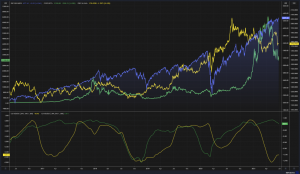With a lot of the conversation around the utility of cryptocurrencies seeming to shift from their use as practical alternative means of exchange to instead being thought of as a new asset class, one should probably then evaluate what would be the benefits of adding such an asset class to a portfolio. Notwithstanding the stellar absolute returns of cryptocurrencies over the past decade, a separate debate which we can have about the underlying merits of their fundamentals, we would think it useful to look at one of the most important factors we try to evaluate when adding a new security or asset to our model portfolios: does this new asset provide diversification of performance characteristics to the other assets we hold in that portfolio?
One way to evaluate this diversification factor is to measure the correlation of various assets’ performance against one another. As there is ample commentary from cryptocurrency proponents about this potential new asset classes’ inherent substitutability with precious metals, that would be good place to start in looking at whether say Bitcoin would perform a better job of providing diversification in a portfolio to equities, using the S&P500 as a measure, than say gold.
In looking at a 5-year chart of the three assets in the top panel, S&P500 (Blue), Bitcoin (Green), and Gold (Yellow), and the correlations between the S&P500 and the other two assets in the lower panel, S&P500/Bitcoin (Green) and S&P500/Gold (Yellow), we can see a noticeable difference in the two correlation relationships. It would appear that over the chosen time frame, Bitcoin did seem more correlated in its performance with the S&P500, spending more of the time in positive correlation territory and sometimes exhibiting relatively high correlation (between 0.6 to 0.8) with the S&P500 for stretches of time. This is somewhat in contrast to Gold, where you can see more frequent ping-ponging of its correlation relationship with the S&P500 between positive and negative readings. So, our simple takeaway is that gold, at least for now, seems to serve as a better diversifier to equities than Bitcoin or cryptocurrencies in general.







